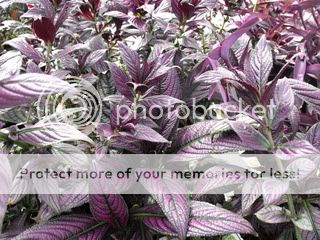Persian Shield

Persian Shield is the common name by which the plant Strobilanthes dyerianus is known. It is easily recognized by its brilliant purple leaves and their silvery sheen. It is a flowering plant but the small blue flowers are insignificant ornamentally. Persian Shield is a sub-shrub and in its natural environment can grow to about four feet tall and three feet wide. Contained in a pot and maintained with some pruning, it makes an excellent indoor specimen plant.
 Persian Shield will grow in just about any light. For the healthiest plant, a few hours of direct sun in the morning or afternoon is beneficial. Keep in mind that direct sun indoors is not as bright as direct sun outdoors. If the light is too strong the leaves will fade or even burn. Bright but diffuse light throughout the day should be the goal.
Persian Shield will grow in just about any light. For the healthiest plant, a few hours of direct sun in the morning or afternoon is beneficial. Keep in mind that direct sun indoors is not as bright as direct sun outdoors. If the light is too strong the leaves will fade or even burn. Bright but diffuse light throughout the day should be the goal.
The water requirements of Persian Shield are pretty flexible. It’s somewhat drought tolerant so you don’t need to fret if you forget about it for a day or two. Just water when the potting mix is dry about half an inch to an inch down. Fertilize with a complete fertilizer at every other watering during the growing season and mist regularly. Cut back on watering and omit fertilizer during the winter months.
Propagation can be done by taking simple stem cuttings. Roots will develop more quickly if bottom-heat is provided. Keep the humidity high around the rooting plantlets. As the small plants begin to grow, pinch them back several times to produce nice full plants. It’s hard to nip back fresh growth sometimes, but remember that all your patience will be rewarded in the end and pinched tips can often be rooted themselves.
Pruning will need to be done occasionally to keep the plant healthy and looking good. Follow the one-third rule of thumb; removing more than one-third of the branches or roots at a time can be too stressful so trim a little modestly. Take dead or damaged branches off first. You may then want to thin out the interior of the plant to allow light and air to filter inside. Do shaping last.
This plant will likely attain a large size and so should be grown on the floor. Persian Shield has been cultivated since at least the Victorian times and is not known to present any danger to pets or children so it can safely be grown within their reach. It is not an irritant of the skin nor is it toxic to ingest, though I’m sure it would not be pleasant to eat.

The water requirements of Persian Shield are pretty flexible. It’s somewhat drought tolerant so you don’t need to fret if you forget about it for a day or two. Just water when the potting mix is dry about half an inch to an inch down. Fertilize with a complete fertilizer at every other watering during the growing season and mist regularly. Cut back on watering and omit fertilizer during the winter months.
Propagation can be done by taking simple stem cuttings. Roots will develop more quickly if bottom-heat is provided. Keep the humidity high around the rooting plantlets. As the small plants begin to grow, pinch them back several times to produce nice full plants. It’s hard to nip back fresh growth sometimes, but remember that all your patience will be rewarded in the end and pinched tips can often be rooted themselves.
Pruning will need to be done occasionally to keep the plant healthy and looking good. Follow the one-third rule of thumb; removing more than one-third of the branches or roots at a time can be too stressful so trim a little modestly. Take dead or damaged branches off first. You may then want to thin out the interior of the plant to allow light and air to filter inside. Do shaping last.
This plant will likely attain a large size and so should be grown on the floor. Persian Shield has been cultivated since at least the Victorian times and is not known to present any danger to pets or children so it can safely be grown within their reach. It is not an irritant of the skin nor is it toxic to ingest, though I’m sure it would not be pleasant to eat.
This site needs an editor - click to learn more!
You Should Also Read:
Pruning Houseplants
Summering Houseplants Outdoors
Houseplants Newsletter 
Related Articles
Editor's Picks Articles
Top Ten Articles
Previous Features
Site Map
Content copyright © 2023 by Lisa Beth Voldeck. All rights reserved.
This content was written by Lisa Beth Voldeck. If you wish to use this content in any manner, you need written permission. Contact
BellaOnline Administration
for details.


